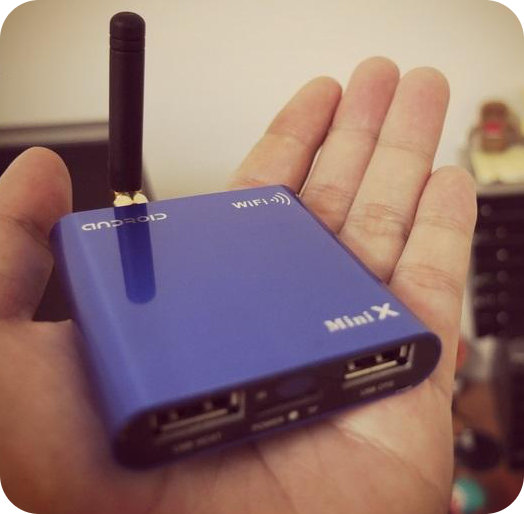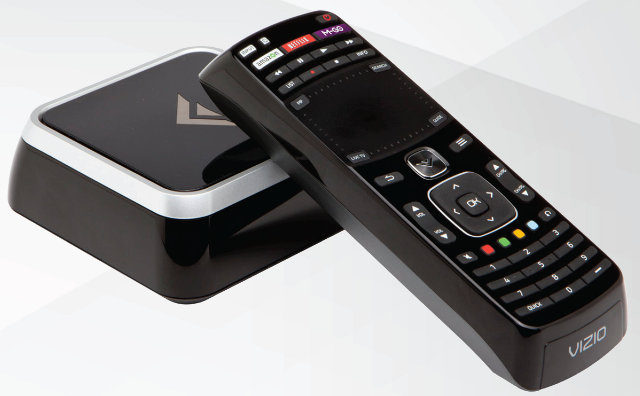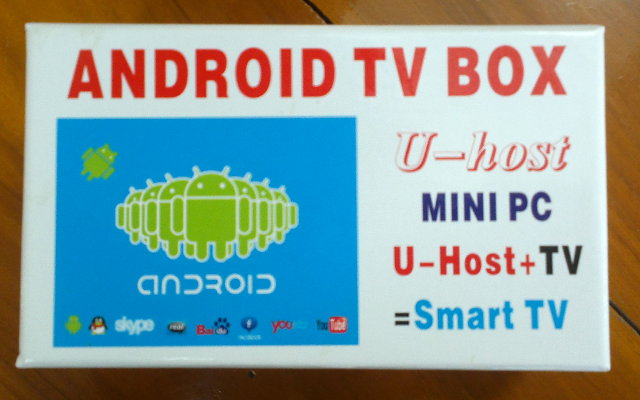I previously wrote about Mini X media player, an Android mini Media Player powered by AllWinner A10 with 512 MB RAM that runs Android 2.3. Its price has been reduced by about $10 to $67.60, and it now has a big brother called Mini Xplus that looks exactly the same except it runs Android 4.0 and comes with 1GB RAM according to Deal Extreme. Here are the device specifications based on Deal Extreme overview: CPU – AllWinner A10 (Cortex A8) with Mali-400 GPU @ 1.2 GHz Memory – 1GB DDR3 RAM Storage – 4GB NAND Flash, microSD slot Video Output – HDMI 1.3 and Composite USB – 2x USB 2.0 host Connectivity – WiFi 802.11 b/g/n Video Formats – MKV, TS, TP, M2TS, RM/RMVB, BD-ISO, AVI, MPG, VOB, DAT, ASF, TRP, FLV etc Video Codecs – MPEG1/2/4, H.264, VC-1, Divx, Xvid, RM8/9/10, VP6 Subtitle – SRT, SUB, IDX, SSA, SMI […]
Vizio Co-Start (VAP430) Google TV Stream Player
First announced at CES 2012, the Vizio VAP430 stream player featuring Google TV 2.0 has become available for pre-order for $99 last week. Here are the specs provided on Vizio website: Video Resolution Supported – 720p, 1080i, 1080p 3D Support – Yes Video Playback – H.264, MP4, MKV Audio Music Playback – MP3, AAC, WMA Audio Features – Up to 5.1 surround sound pass-through Connectivity WiFi – 802.11 n/g/b Bluetooth Ethernet – 10/100 Mbps Connections HDMI In – Connection to Cable or Satellite Box HDMI Out – Connection to TV One USB 2.0 Host port Remote control – Built-In IR Blaster, Bluetooth, Touchpad and Keyboard Dimension – 10.67 x 4.06 x 10.67 cm Weight – 300 grams They did not provide information about the processor, RAM and flash used, but I would guess it’s based on Marvell Google TV Reference Platform which is powered by ARMADA 1500 HD Secure Media […]
Android Jelly Bean on Samsung Origen Development Board (Video)
Linaro Android team has started to port Android Jelly Bean to Samsung Origen board (powered by Exynos 4 dual core processor) and can now show Android 4.1 running on the board with hardware accelerated graphics. This is a preliminary image: the touchscreen, graphics, adb works, and you can use keyboard and mouse as input devices, but Wi-Fi, Bluetooth and multimedia (hardware video decoding) still have to be worked on. If you have an Origen board, you can give it a try by downloading the binaries @ https://android-build.linaro.org/builds/~linaro-android/origen-jb-gcc47-samsunglt-stable-blob/, and follow the instructions to create a bootable SD card with linaro-media-create. Jean-Luc Aufranc (CNXSoft)Jean-Luc started CNX Software in 2010 as a part-time endeavor, before quitting his job as a software engineering manager, and starting to write daily news, and reviews full time later in 2011. www.cnx-software.com
Smallart U-Host mini PC Unboxing and Review
I’ve just received a Smallart Uhost mini PC based on AllWinner A10 from the “The Cubies hacker shop” on Aliexpress. The device features 1GB RAM, 4B flash, includes 802.11 b/g/n built-in, USB ports, HDMI output and a microSD card. It costs $70 including shipping. I received the device in the simple package below. There is a whole bunch of stuffs inside the package. A USB to mini USB cable for power and to connect the device to PC to act as a USB drive, the Smallart U-host mini PC itself, a user manual in English, the power supply 5V/2A with a USB port, an HDMI female to male cable. The USB to mini USB cable has actually 2 large USB connector in order to provide up to 5W power (2 x 500mA x 5V). The mini PC has several connectors including an HDMI male connector, a USB Host port (for […]
Linaro 12.07 Release with Kernel 3.5 and Android 4.0.4
Linaro has released version 12.07 based on Linux Kernel 3.5-rc3 and Android 4.0.4. Some work has been done on Jelly Bean (but the port is for next month), several benchmark tools have been added to LAVA as Linaro wants to provide standard benchmarks for Android, Linaro ALIP image now uses LXDE by default with a smaller image and improved performance, and Open Embedded images are now available (minimal and LAMP stack). Here are the highlights of the release: Android Jellybean baselines for Galaxy and Panda with Linaro extra’s available Android Benchmarking apps were deployed for pandaboard, snowball and origen in LAVA including: vellamo, quadrant, nbench, linpack, glbenchmark, geekbench, caffeinemark, antutu, andebench Improved native Benchmarks variance on Android to 1%, working on Java variance ICS “tests” builds now produced by default and test lists generated Open overlay tarballs working pm-qa’s cpuidle cpufreq cpuhotplug sched_mc suspend integrated into the Android builds Linaro […]
VIA Releases Kernel 2.6.32 and U-Boot Source Code for $49 APC Board
VIA Technology unveiled the low cost APC (Android PC) board based on WonderMedia WM8750 processor (ARM11) back in May, and started to ship the Android board this month (I think since that was their plan). The company has just released Kernel 2.6.32.9 and U-Boot source on github. Here’s how to retrieve the code provided git is already installed on your machine:
|
1 |
git clone git://github.com/apc-io/apc-8750.git |
You can then build U-Boot (provided you’ve already installed an ARM toolchain in your path):
|
1 2 3 |
cd $CURRENT_PATH/u-boot make wmt_config make all |
and the Linux kernel:
|
1 2 3 |
cd $CURRENT_PATH/kernel make 8710_defconfig make ubin |
The availability of the source means we should see Linux distribution like Debian, Fedora or Arch Linux ARM (separate from Arch Linux) running on the board very soon. In theory, it’s also possible to run a Linux distribution with the binary Linux kernel compiled for Android, but it causes some issues and also makes customization more difficult. I think they should also have release the code they modified […]
LinuxCon North America 2012 Schedule
LinuxCon (North America) 2012 will take place on August 29 – 31, 2012 at Sheraton Hotel & Marina, in San Diego, California. The event will be co-located with the Linux Kernel Summit, the Linux Plumbers Conference, and CloudOpen 2012. LinuxCon consists of 3 days of keynotes, business and developers related sessions as well as tutorials. There will be over 80 sessions and keynotes during those 3 days. I’ll highlight a few sessions that I find particularly interesting and related to embedded Linux, software development and ARM. August 29 10:45 – 11:30 – Life After BerkeleyDB: OpenLDAP’s Memory-Mapped Database by Howard Chu, Symas Abstract: OpenLDAP’s new MDB library is a highly optimized B+tree implementation that is orders of magnitude faster and more efficient than everything else in the software world. Reads scale perfectly linearly across arbitrarily many CPUs with no bottlenecks, and data is returned with zero memcpy’s. Writes are on […]
Discounted and Free Development Kits by Future Electronics and Texas Instruments
If you have a project in mind, Future Electronics and Texas Instruments are currently offering free development boards and 50% discounts on selected development kits respectively. Future Electronics Boards4Free Initiative In August, Future Electronics will be giving away 5 boards every Wednesday (20 boards in total). Here’s how it works: Every Wednesday at 12 pm EST from August 1 to August 22 Future Electronics will post a board on their Twitter, Facebook and Google+ feeds. Reply to them on Twitter, comment on their post on Facebook or comment on their post on Google+ with your project idea to enter into the contest. Each action counts as on entry, so you can get up to 3 entries Each weekly drawing period begins at 12 pm EST and ends at 12:30 pm EST. (So you’ve just got 30 minutes to enter, unless I missed something) Future Electronics will draw 5 winners and […]








